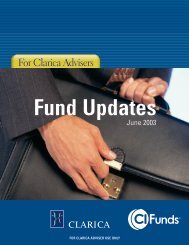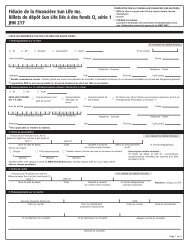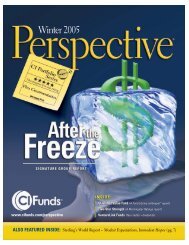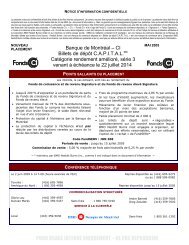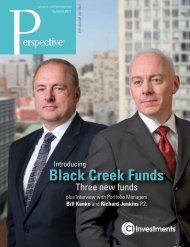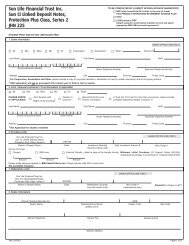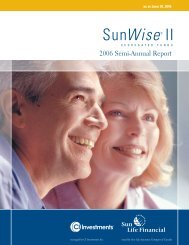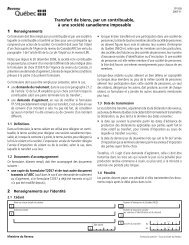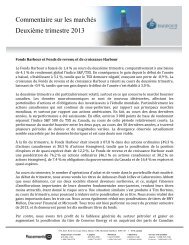COMMENTARYLegg Mason Capital ManagementThe current bull market celebrated its first birthday on<strong>March</strong> 9, but with little fanfare. The Wall Street Journalwrote a subdued front page story on the event, but the NewYork Times and Financial Times barely made note of it.This strikes us as odd, and probably quite bullish, since the12-month return of the S&P 500 Index from <strong>March</strong> 9, 2009(+72.29%) was the best in over 70 years. Instead of sportingparty hats, many observers seem more inclined to fret aboutwhen the next correction might begin. Michael Santoli’s<strong>March</strong> 15, 2010 Streetwise column in Barron’s entitled “IsAnother Market Pullback Near?” exemplified the cautiousmood, failing to even mention the fact that the bull’s firstbirthday had occurred in the previous week.In early 2009, in many respects, it required a considerableleap of faith to be bullish on equities. Among other things,one had to believe that frozen credit markets would thaw,that gapping credit spreads would normalize, that thebanking system would survive and that the sickening yearlongdecline in global equity markets would one day end.Many investors were unwilling or unable to make that leapof faith and, as a consequence, have missed one of the mostpowerful upswings in stock market history.In our judgment, no such leap of faith is required todayto be bullish on equities. An objective evaluation of theavailable evidence should be sufficient to do so, in ouropinion. Credit markets have healed, credit spreads havenarrowed and the banking system has been recapitalized.Most economic indicators point to recovery and corporateprofits have snapped back strongly. So far, for many investors,the evidence has not been sufficient to persuade them to bebullish.While appeals to reason may continue to be unpersuasiveto some, we continue to believe it is worthwhile to makethe bull case for equities. As with a simple tripod, the caserests solidly on three legs: (1) the technical condition of themarket itself, (2) the nascent economic recovery, and (3) theoutlook for corporate earnings and resultant valuation of themarket.From a purely technical point of view, the market isabout as healthy as it ever gets. Most major indices are“in gear” on the upside, meaning that the index is tradingabove its own 10-day moving average, which is above the50-day moving average, which is, in turn, above the 200-day moving average, and all of those moving averages arerising. In addition, nearly every major market index – withthe lone exception of the Dow Jones Utilities Index – hasrecently made a new recovery high. Moreover, the NYSEAdvance/Decline Line and the NYSE Daily Net New Highindex have also both posted new recovery highs in thelast few days. Historically, at major market turning points,divergences develop between the popular averages (suchas the Dow Industrials and S&P) and measures of marketbreadth (such as the advance/decline line). In other words,trouble develops when the generals lead and the troops stopfollowing. No such divergences exist today.In fact, the Leuthold Group notes in its April monthlythat: “Market strength is so pervasive that NYSE NetNew Highs (on a six-week moving average basis) movedto yet another new bull market high for the week endedApril 1. Historically, a new high in this indicator has servedto “reset the clock” on the cyclical bull market. Following abull market peak in Net New Highs since 1940, the medianbull market has lasted another two years and delivered anadditional S&P gain of 32%. (After the worst signal fromthe indicator, the cyclical bull market still lasted another 30weeks and produced an additional 7% gain.)”As far as the economic backdrop is concerned, we believethat the economy bottomed in June or July of last year andPAGE 46 • SPRING 2010 PERSPECTIVE AS AT MARCH 31, 2010
COMMENTARYthat the recovery is beginning to gain traction. The Institutefor Supply Management (ISM) data has been signallingexpansion for a number of months. That trend continues asthe ISM announced that its composite index rose to 55.4 in<strong>March</strong>, up from 53.0 in February, and better than consensusexpectations of 54.0. Earlier, the ISM had reported that itsfactory index rose to 59.6 in <strong>March</strong>, its highest level sinceJuly 2004. The latest release indicates that the recoverymay be broadening out beyond manufacturing into servicesegments. Service industries expanded in <strong>March</strong> at the fastestpace since May 2006. The ISM’s gauge of new orders grewto 62.3 in <strong>March</strong>, the highest mark since August 2005 anda significant jump from February’s 55.0 reading. Finally,export orders improved last month as well, rising to 57.5 from47.0 in February.An important element of the recovery picture fell into place,when the Bureau of Labor Statistics (BLS) reported that nonfarmpayrolls increased 162,000 in <strong>March</strong>, the best showingin three years. Total job growth came in somewhat belowexpectations of 184,000, because census hiring was belowexpectations. Private sector job gains, on the other hand,were better than expected at 123,000. The BLS’s householdsurvey (which includes small businesses) showed a gain of264,000. We think the resumption of job growth shouldprovide an important psychological boost to both businessesand consumers, as job losses during the recession generatedan enormous amount of media attention. As encouragingas the data are, with the unemployment rate remaining at+9.7% and the underemployment rate still higher at +16.9%,we believe the Federal Reserve will feel little pressure toboost the Fed funds rate any time soon, even if job growthaccelerates in coming months, as we expect.growth of about 37%, according to Thomson Reuters.They are also expected to see revenue growth averagingabout 10%, the second quarterly gain in a row after fourconsecutive declines. The resumption of revenue growthcould turbocharge earnings growth rates for many companieswhose strong earnings performance up to this point has beendriven largely by cost cutting.Bottom-up consensus 2010 EPS estimates for the S&P 500Index are approaching $80 per share, according to ThomsonReuters, while expectations for 2011 are about $96.50. It isuncertain at this point whether these expectations will berealized or not, but if they are anywhere close, then the S&P500 at about 15x 2010 estimates and 12.5x expectations for2011 is very reasonably priced.In summary, we believe most investors remain far toopessimistic about the outlook for equities. The economy isclearly in recovery, corporate earnings are booming and stocksare not expensive. With the Fed likely to be on hold until latethis year due to moderating rates of core inflation, slack inthe economy and continuing high rates of unemployment,we think we are in the sweet spot of the equity investmentcycle. Stocks are clearly not as cheap as they were a year ago,but they are still attractive, in our view, especially relativeto cash – which yields next to nothing – and bonds, whichface the headwind of rising long-term interest rates. Risinglong rates will ultimately pose a headwind for equities, butin the near term, powerful earnings growth will mitigate thedamage, in our view.Managers: Bill Miller, Mary Chris GayThe outlook for corporate earnings continues to be robustas well. Fourth quarter 2009 results are in and 72% ofcompanies beat consensus expectations, according to theWall Street Journal. The outlook for the first quarter of 2010is for more of the same. The ratio of negative to positiveearnings pre-announcements, which typically averages about2-to-1, is only running 1.3-to-1 for the first quarter. Firms inthe S&P 500 are expected to report year-over-year earningsPAGE 47 • SPRING 2010 PERSPECTIVE AS AT MARCH 31, 2010
- Page 5: Signature Reportof the average bond
- Page 8 and 9: Signature ReportSignature Diversifi
- Page 10: Signature ReportMarket RoundupGloba
- Page 13 and 14: Signature ReportHealth careTechnolo
- Page 15 and 16: Signature ReportHigh-yield bondsGeo
- Page 17 and 18: Sterling’sWorld ReportIs Greece a
- Page 19 and 20: Sterling’sWorld Reportof only 3.7
- Page 22 and 23: Spotlight onStephen JenkinsGood man
- Page 24 and 25: Spotlight onStephen JenkinsHarbourF
- Page 26 and 27: Spotlight onStephen JenkinsAryzta A
- Page 28 and 29: Harbour Growth & Income FundHarbour
- Page 30 and 31: Balanced OpportunitiesFundHarbour G
- Page 32 and 33: CI IncomeOpportunities -Fund Highli
- Page 34 and 35: Reprinted with permission from The
- Page 36 and 37: COMMENTARYCambridge AdvisorsMost of
- Page 38 and 39: COMMENTARYFor the income portfolios
- Page 40 and 41: COMMENTARYquarters, the backdrop fo
- Page 42 and 43: COMMENTARYinventories throughout th
- Page 44 and 45: COMMENTARYEpoch Investment Partners
- Page 46 and 47: COMMENTARYTetrem Capital Management
- Page 50 and 51: COMMENTARYAltrinsic Global Advisors
- Page 52 and 53: pressure, investors will be searchi
- Page 54 and 55: Fund Factsas at March 31, 2010Fund
- Page 56 and 57: Fund Factsas at March 31, 2010Fund
- Page 58 and 59: Fund Factsas at March 31, 2010Fund
- Page 60 and 61: Fund Factsas at March 31, 2010Fund
- Page 62 and 63: Fund Factsas at March 31, 2010Fund
- Page 64 and 65: Fund Factsas at March 31, 2010Fund
- Page 66 and 67: Fund Factsas at March 31, 2010Fund
- Page 68 and 69: Fund Factsas at March 31, 2010Fund
- Page 70 and 71: Fund Factsas at March 31, 2010Fund
- Page 72 and 73: Fund Factsas at March 31, 2010Fund
- Page 74 and 75: Fund Factsas at March 31, 2010Fund
- Page 76 and 77: Fund Factsas at March 31, 2010Fund
- Page 78 and 79: Fund Factsas at March 31, 2010Fund
- Page 80 and 81: Fund Factsas at March 31, 2010Fund
- Page 82 and 83: Fund Factsas at March 31, 2010Fund
- Page 84 and 85: Fund Factsas at March 31, 2010Fund
- Page 86 and 87: CI Funds ® LEAD MANAGERCDN $FUND C
- Page 88 and 89: CI Corporate ClassLEAD MANAGERCDN $
- Page 90 and 91: Labour-sponsored FundsLEAD MANAGERC
- Page 92 and 93: CI Segregated FundsIssued by Unity
- Page 94 and 95: Clarica PortfolioSegregated FundsIs
- Page 96 and 97: SunWise ® I FundsBasic GuaranteeIs
- Page 98 and 99:
SunWise ® II FundsBasic Guarantee
- Page 100 and 101:
SunWise ® II FundsCombined Guarant
- Page 102 and 103:
SunWise ® II FundsCombined Guarant
- Page 104 and 105:
SunWise ® II FundsFull Guarantee c
- Page 106 and 107:
SunWise ® Elite FundsBasic Guarant
- Page 108 and 109:
SunWise ® Elite FundsCombined Guar
- Page 110 and 111:
CI Sales TeamNeal KerrSenior Vice-P
- Page 112:
2009Analysts’ ChoiceInvestment Fu



